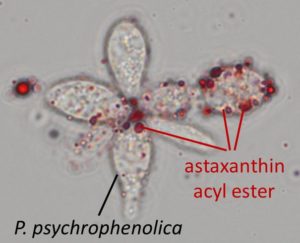26 Oct | 2025, July | A MICROSCOPIC FUNGUS ASSOCIATED WITH SNOW ALGAE!
The snows and ice of polar regions and mountain summits are not inert deserts!
They harbor a still little-known microscopic biodiversity — including microalgae that, like tiny forests, capture atmospheric CO₂ and transform it into spectacularly pigmented biomass, responsible for the famous “red snows.”
But what becomes of this biomass trapped in the ice once the algae die?
A study from the AlpAlga consortium, conducted with the support of the French National Research Agency (ANR), Greenlandia, and the Kilian Jornet Foundation, and published in Communications Biology, reveals the key role of a microscopic fungus thriving across icy regions.
Called Phenoliferia, this fungus is a true craftsman of organic matter recycling.
It decomposes algal pigments and molecules thanks to a genome among the richest known in genes coding for degradation enzymes. Moreover, it holds the world record for the number of ice-binding proteins, a unique asset for surviving in extreme cold.
By transforming the organic matter fixed by the algae, this invisible fungus establishes an essential link between snow, ice, and neighboring soils — embedding the cryosphere within the global carbon cycle.
Behind the beauty of the “red snows” lies a powerful duo: algae that capture CO₂ and microscopic fungi that recycle their biomass.
This discovery highlights the unexpected strength of snow and glacier biodiversity, whose hidden mechanisms contribute to the resilience of ecosystems in the face of climate change.

In this image, we can see the cells of the fungus, whose surface is covered with the red pigment produced by snow algae — astaxanthin.
Reference : Ezzedine, J.A., Guenzi-Tiberi, P., Villain, G. Aiese Cigliano R., Diagne Y, Franceschi E, Drula E, Forêt J, Valay JG, Procházková L, Remias D, Terrapon N, Amato A, Maréchal E (2025) Snow- and ice-ecosystem cleaning capability of the pucciniomycotinous yeast Phenoliferia psychrophenolica. Communications Biology 8, 1084. https://doi.org/10.1038/s42003-025-08506-w



Sorry, the comment form is closed at this time.